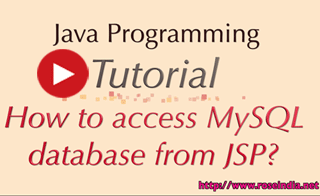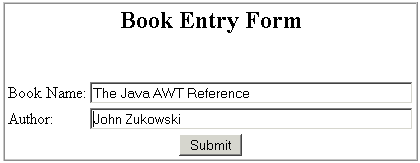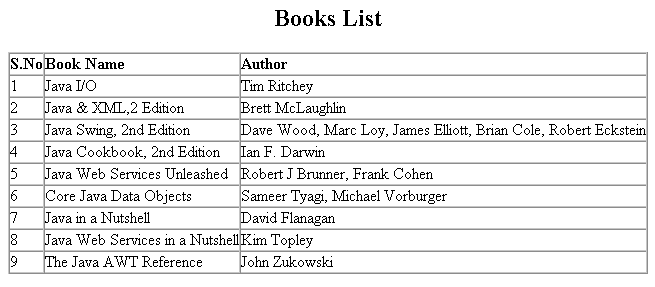Accessing database from JSP
Introduction
In This article I am going to discuss the connectivity from MYSQL
database with JSP.we take a example of Books database. This database
contains a table named books_details. This table contains three fields- id,
book_name& author. we starts from very beginning. First we
learn how to create tables in MySQl database after that we write a html page for
inserting the values in 'books_details' table in database. After
submitting values a table will be showed that contains the book name and author
name.
Database
The database in example consists of a single table of three
columns or fields. The database name is "books" and it contains
information about books names & authors.
Table:books_details
| ID | Book Name | Author |
| 1. | Java I/O | Tim Ritchey |
| 2. |
Java & XML,2 Edition |
Brett McLaughlin |
| 3. | Java Swing, 2nd Edition |
Dave Wood, Marc Loy, |
Start MYSQL prompt and type this SQL statement & press Enter-
MYSQL>CREATE DATABASE `books` ;
This
will create "books" database.
Now we create table a table "books_details"
in database "books".
MYSQL>CREATE TABLE `books_details` (
`id` INT( 11 ) NOT NULL AUTO_INCREMENT ,
`book_name` VARCHAR( 100 ) NOT NULL ,
`author` VARCHAR( 100 ) NOT NULL ,
PRIMARY KEY ( `id` )
) TYPE = MYISAM ;
This will create a table "books_details" in database "books"
Video Tutorial: How to access MySQL database from JSP?
JSP Code
The following code contains html for user interface & the JSP backend-
<%@ page language="java" import="java.sql.*" %> <% String driver = "org.gjt.mm.mysql.Driver"; Class.forName(driver).newInstance(); Connection con=null; ResultSet rst=null; Statement stmt=null; try{
String url="jdbc:mysql://localhost/books?user=
<user>&password=<password>";
con=DriverManager.getConnection(url);
stmt=con.createStatement();
}
catch(Exception e){
System.out.println(e.getMessage());
}
if(request.getParameter("action") != null){
String bookname=request.getParameter("bookname");
String author=request.getParameter("author");
stmt.executeUpdate("insert into books_details(book_name,
author) values('"+bookname+"','"+author+"')");
rst=stmt.executeQuery("select * from books_details");
%>
<html>
<body>
<center>
<h2>Books List</h2>
<table border="1" cellspacing="0" cellpadding
="0">
<tr>
<td><b>S.No</b></td>
<td><b>Book Name</b></td>
<td><b>Author</.b></td>
</tr>
<%
int no=1;
while(rst.next()){
%>
<tr>
<td><%=no%></td>
<td><%=rst.getString("
book_name")%></td>
<td> <%=rst.getString("author")
%> </td>
</tr>
<%
no++;
}
rst.close();
stmt.close();
con.close();
%>
</table>
</center>
</body>
</html>
<%}else{%>
<html>
<head>
<title>Book Entry FormDocument</title>
<script language="javascript">
function validate(objForm){
if(objForm.bookname.value.length==0){
alert("Please enter Book Name!");
objForm.bookname.focus();
return false;
}
if(objForm.author.value.length==0){
alert("Please enter Author name!");
objForm.author.focus();
return false;
}
return true;
}
</script>
</head>
<body> <center> <form action="BookEntryForm.jsp" method="post" name="entry" onSubmit="return validate(this)"> <input type="hidden" value="list" name="action"> <table border="1" cellpadding="0" cellspacing="0"> <tr> <td> <table> <tr> <td colspan="2" align="center"> <h2>Book Entry Form</h2></td> </tr> <tr> <td colspan="2"> </td> </tr> <tr> <td>Book Name:</td> <td><input name="bookname" type= "text" size="50"></td> </tr> <tr> <td>Author:</td><td><input name= "author" type="text" size="50"></td> </tr> <tr> <td colspan="2" align="center"> <input type="submit" value="Submit"></td> </tr> </table> </td> </tr> </table> </form> </center> </body> </html> <%}%> |
Now we explain the above codes.
Declaring Variables: Java is a strongly typed language which means, that variables must be explicitly declared before use and must be declared with the correct data types. In the above example code we declare some variables for making connection. Theses variables are-
Connection con=null;
ResultSet rst=null;
Statement stmt=null;
The objects of type Connection, ResultSet
and Statement are associated with the Java sql.
"con" is a Connection type object variable that will hold Connection
type object. "rst" is a ResultSet type object variable that will hold
a result set returned by a database query. "stmt" is a object variable
of Statement .Statement Class methods allow to execute any query.
Connection to database: The first
task of this programmer is to load database driver. This is achieved using the
single line of code :-
String driver = "org.gjt.mm.mysql.Driver";
Class.forName(driver).newInstance();
The next task is to make a connection. This is done using the single line of code :-
String url="jdbc:mysql://localhost/books?user=<userName>&password=<password>";
con=DriverManager.getConnection(url);
When url is passed into getConnection() method of DriverManager class it returns connection object.
Executing Query or Accessing data from database:
This is done using following code :-
stmt=con.createStatement(); //create a Statement
object
rst=stmt.executeQuery("select * from books_details");
stmt is the Statement type variable
name and rst is the RecordSet type variable. A query is always executed
on a Statement object.
A Statement object is created by calling createStatement() method on connection
object con.
The two most important methods of this Statement interface are executeQuery() and executeUpdate(). The executeQuery() method executes an SQL statement that returns a single ResultSet object. The executeUpdate() method executes an insert, update, and delete SQL statement. The method returns the number of records affected by the SQL statement execution.
After creating a Statement ,a method
executeQuery() or executeUpdate() is called on Statement object stmt and
a SQL query string is passed in method executeQuery() or executeUpdate().
This will return a ResultSet rst related to the query string.
Reading values from a ResultSet:
while(rst.next()){
%>
<tr><td><%=no%></td><td><%=rst.getString("book_name")%></td><td><%=rst.getString("author")%></td></tr>
<%
}

The ResultSet
represents a table-like database result set. A ResultSet object
maintains a cursor pointing to its current row of data. Initially, the cursor is
positioned before the first row. Therefore, to access the first row in the ResultSet,
you use the next() method. This method moves the cursor to the next
record and returns true if the next row is valid, and false
if there are no more records in the ResultSet object.
Other important methods are getXXX()
methods, where XXX is the data type returned by the method at the
specified index, including String, long, and int.
The indexing used is 1-based. For example, to obtain the second column of type
String, you use the following code:
resultSet.getString(2); 0
You can also use the getXXX()
methods that accept a column name instead of a column index. For instance, the
following code retrieves the value of the column LastName of type String.
resultSet.getString("book_name");
The above example shows how you can use
the next() method as well as the getString() method.
Here you retrieve the 'book_name' and 'author' columns from a table called 'books_details'.
You then iterate through the returned ResultSet and print all the
book name and author name in the format " book name | author " to the
web page.
1
Summary:
This article presents JDBC and shows how
you can manipulate data in a relational database from your JSP page. To do
this, you need to use the java.sql package: DriverManager, Connection,
Statement, and ResultSet. Keep in mind, however, that
this is only an introduction. To create a Web application, you need JDBC
to use more features such as prepared statements and connection pooling.
To Download Example click
here
When you click on the above link a Book Entry Form
will open
2

Fill the book name and author fields and press Submit button. A page will open and show a table of book name and authors like... 3

